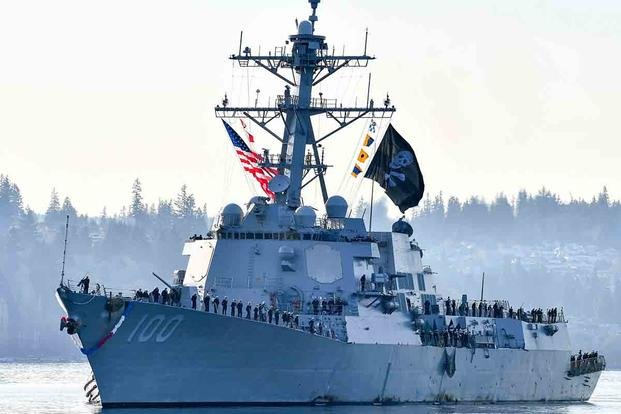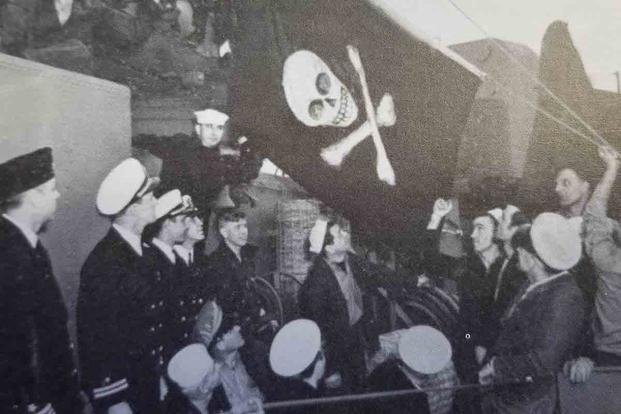 By Blake Stilwell
By Blake Stilwell
Although there are dozens of active Arleigh Burke-class guided missile destroyers in the U.S. Navy’s fleet, there’s something special about the USS Kidd. It doesn’t have any secret technology or weapons (that we know of), and its capabilities are the same as any other of its class. The standout feature that tends to capture the attention of even the most landlubberly civilian is the massive Jolly Roger that the Kidd is often seen flying from its mast.
The USS Kidd’s pirate flag, the infamous skull and crossbones that hearkens back to the Golden Age of Piracy that spanned the 17th and 18th centuries, is the only one the U.S. Navy has ever allowed to fly on one of its ships. And like most bizarre things that happen inside the Navy, it starts with an honored tradition, one dating back to World War II.
Pirates these days don’t really think about hoisting a Jolly Roger to announce their intentions. They usually just go in for the killing and stealing. So if a U.S. Navy vessel flies the old pirate flag when returning to port (and some do), it’s all in good fun. No one thinks the submarine USS Jimmy Carter, which was spotted flying the pirate banner back in 2017, is actually out there terrorizing sea lanes and stealing doubloons.
But in the Navy, old habits die real hard. There’s no better example than the fact that U.S. sailors wore bell-bottom trousers until the 21st century. So even though most of its ships are more likely to kill pirates than join them, the Navy brass still frowns on making light of lawlessness at sea by raising the Jolly Roger.
Yet, not so much with the USS Kidd. The Kidd gets a pass because of tradition, the most powerful force in the Navy. Tradition is what keeps Navy coffee mugs unwashed and sailors eating cherries out of belly buttons (you’re gonna have to ask a “shellback” about that one; don’t Google it at work).

The USS Kidd is named for Rear Admiral Isaac C. Kidd, who was killed aboard the battleship USS Arizona during the Japanese attack on Pearl Harbor in 1941, the first American flag officer to die in World War II. As he was the commander of Battleship Division One, he ran to the bridge of Arizona, his flagship, to take command during the outset of the surprise attack. He died aboard the ship with 1,175 of his sailors and Marines, and was posthumously awarded the Medal of Honor.
Rear Adm. Kidd picked up the nickname “Cap” while attending the U.S. Naval Academy, a reference to the infamous privateer-turned-pirate Capt. William Kidd, who was executed for the crime in 1701. When a Fletcher-class destroyer was named for Rear Adm. Kidd in 1943, its crew immediately adopted the pirate theme, with the blessing of Isaac Kidd’s widow, Inez. Inez Kidd even convinced the Navy to formally give the USS Kidd express permission to fly the pirate flag.

That first crew of the Kidd began calling themselves “the Pirates of the Pacific,” picking up downed naval aviators and returning them to their carriers in exchange for a “ransom” of ice cream. That initial USS Kidd, which served the U.S. Navy off and on until 1964, is now a museum ship. In 1981, a new USS Kidd, the first of its eponymous class of warships, entered service and inherited the tradition (and permission) to hoist the Jolly Roger until it was given to Taiwan in 1998.
And so it was for the latest USS Kidd when it was commissioned in 2007. It not only flies the pirate flag when entering and leaving port, but when the vessel makes its way between the U.S. coasts and during multinational exercises, as well. The skull and crossbones can also be seen on the rear of the Kidd’s five-inch guns, on its internal doors and probably tattooed on a fair number of its sailors.
A lot of Arleigh Burke-class destroyers are out there, named for a great number of the Navy’s leaders and heroes. The USS Kidd (and the Kidds that come after it) will always be the only ship flying the Jolly Roger as part of its own unique piece of history.





